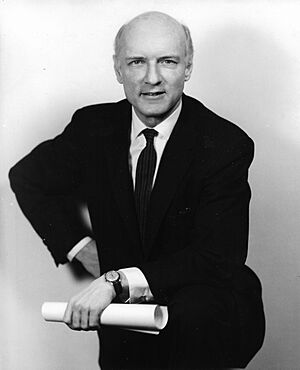Heinz von Foerster facts for kids
Quick facts for kids
Heinz von Foerster
|
|
|---|---|

At the Biological Computer Laboratory, the University of Illinois in 1963
|
|
| Born |
Heinz von Förster
November 13, 1911 Vienna, Austria-Hungary
|
| Died | October 2, 2002 (aged 90) Pescadero, California, U.S.
|
| Nationality | Austria United States |
| Alma mater | Technical University of Vienna University of Breslau |
| Known for | Von Foerster equation Second-order cybernetics Computer science Artificial intelligence Epistemology Biophysics |
| Awards | Wiener Gold Medal (1983) |
| Scientific career | |
| Fields | Cybernetics Physics Philosophy |
| Institutions | University of Illinois at Urbana–Champaign |
Heinz von Foerster (born November 13, 1911 – died October 2, 2002) was an important Austrian-American scientist. He combined ideas from physics and philosophy. He is widely known for creating something called second-order cybernetics.
He was a very smart person who worked in many different areas. He wrote almost 200 papers on topics like computer science, artificial intelligence, and how we gain knowledge (this is called epistemology). He also studied high-speed electronics and how our brain works. Heinz von Foerster was called "one of the most important thinkers in the history of cybernetics".
He moved to the United States and helped start the Biological Computer Laboratory. This lab built one of the first parallel computers called the Numa-Rete. He worked with other famous scientists like William Ross Ashby, Warren McCulloch, and Norbert Wiener. Together, they helped shape the field of cybernetics. He also helped organize the Macy conferences, which were important meetings where scientists discussed cybernetics.
Contents
Biography
Heinz von Foerster was born in Vienna, Austria-Hungary, in 1911. He studied physics at the Technical University of Vienna and the University of Breslau. He earned his PhD in physics in 1944.
In 1949, he moved to the United States. He started working at the University of Illinois at Urbana–Champaign. He became a professor of electrical engineering in 1951. Later, he also became a professor of biophysics and directed the Biological Computer Laboratory. He was recognized for his work and received a special award called the Guggenheim Fellowship twice.
Heinz von Foerster knew and talked with many other famous thinkers. These included John von Neumann, Norbert Wiener, and Margaret Mead. He was a great teacher and helped many students. He encouraged them to work together and explore new ideas.
He passed away on October 2, 2002, in Pescadero, California.
His Work and Ideas
Von Foerster was interested in cybernetics, which is the study of how systems control themselves and communicate. Think about how a thermostat controls the temperature in a room, or how your body controls its temperature. He is famous for inventing "second-order cybernetics." This idea looks at how the person observing a system is also part of that system. He also made big contributions to constructivism, which is the idea that we build our own understanding of the world.
The Electron Tube Laboratory
In 1949, von Foerster began working at the electron tube laboratory at the University of Illinois at Urbana–Champaign. There, he and his students created many new electronic devices. These included very fast electronic parts.
He also worked on mathematical ways to understand how populations change. In 1959, he published a model known as the "von Foerster equation." This equation helps predict how a population will grow or shrink over time. It considers things like how old people are and how many people might die at different ages.
Biological Computer Laboratory
In 1958, Heinz von Foerster started the Biological Computer Lab. In this lab, scientists studied how similar control systems work in both biology (like living things) and electronics (like computers). They looked for connections between how our brains work and how computers could be designed.
Macy Conferences
He was one of the youngest members of a special group at the Macy conferences. These meetings were very important for the early development of cybernetics. Heinz von Foerster helped edit the books that came out of these conferences. He was the one who suggested calling these meetings "Cybernetics" conferences. Before that, they had a much longer name!
The Doomsday Equation
In 1960, Heinz von Foerster and his team published an article in Science magazine. They shared a formula that tried to predict future world population growth. Based on their formula, they jokingly predicted that the world's population growth would become "infinite" by Friday, November 13, 2026. This date was also von Foerster's 115th birthday! This prediction earned the formula the nickname "the Doomsday Equation."
They found that world population growth was getting faster than simply doubling. This meant the time it took for the population to double was getting shorter and shorter. Von Foerster's "Doomsday" prediction was a funny way to show that this trend couldn't continue forever. Of course, biological systems don't usually grow like that for a very long time. People who knew von Foerster understood that he had a great sense of humor.
See also
 In Spanish: Heinz von Foerster para niños
In Spanish: Heinz von Foerster para niños
- Logarithmic timeline
- Macy conferences
- Power law: The equation he used for his population prediction is a type of power law.
- List of dates predicted for apocalyptic events
- The Dream of Reality by Lynn Segal, 1986. This book explains von Foerster's ideas about how we build our own understanding of reality.
- Malthusian growth model
- Jakob von Uexküll

